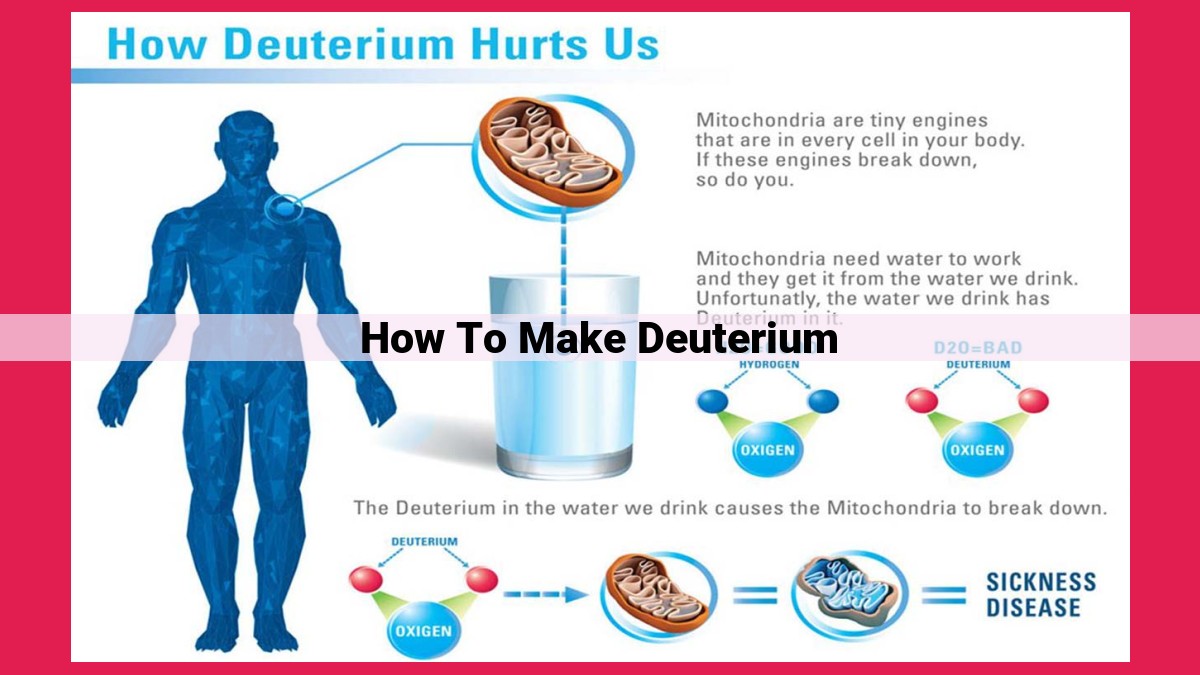Deuterium: The Enigmatic Hydrogen Isotope For Science And Industry

Deuterium, an isotope of hydrogen with an extra neutron, holds immense scientific and industrial significance. Its abundance in heavy water enables enrichment through electrolysis and distillation. Nuclear reactions involving deuterium, such as fusion and fission, harness its potential for energy. Electrolysis, a process that separates hydrogen isotopes, offers a viable method for deuterium production on an industrial scale. These techniques pave the way for advancements in nuclear energy, medical imaging, and future fusion energy endeavors.
Deuterium: The Mysterious Heavy Hydrogen Isotope
Embark on a journey into the enigmatic world of deuterium—a fascinating isotope of hydrogen that holds profound scientific significance. Unlike its more common counterpart, protium, deuterium possesses an additional neutron, making it a valuable resource for a multitude of industries, including nuclear energy and medical imaging.
Deuterium, denoted by the symbol ²H, is an isotope of hydrogen that contains one proton, one neutron, and one electron. Its discovery in 1931 marked a pivotal moment in the field of nuclear physics. Since then, deuterium has become a cornerstone of scientific research and a driving force behind technological advancements.
In the realm of nuclear energy, deuterium serves as a key player in both fission and fusion reactions. In nuclear reactors, deuterium-based heavy water acts as a moderator, slowing down neutrons to facilitate the controlled release of energy through nuclear fission. Moreover, deuterium holds immense promise for the future of energy production, as it is a potential fuel source for nuclear fusion reactors.
Deuterium also shines in the field of medical imaging. When combined with oxygen to form heavy water, it is used in magnetic resonance imaging (MRI) scanners. MRI utilizes the magnetic properties of deuterium to provide detailed images of the human body, aiding in the diagnosis and treatment of various medical conditions.
Beyond its nuclear and medical applications, deuterium finds use in a range of other fields. It is employed as a tracer in chemistry, allowing scientists to track the movement of molecules in complex systems. Deuterium-enriched fuels have also been developed for use in rocket propulsion, enhancing their efficiency and performance.
As we delve deeper into the world of deuterium, we cannot overlook its natural abundance. Deuterium accounts for approximately 0.015% of naturally occurring hydrogen. While this may seem insignificant, its unique properties and industrial applications make it a highly sought-after isotope.
The production of deuterium is a complex and energy-intensive process. Currently, the most common method involves electrolysis, where water is split into hydrogen and oxygen using an electric current. By carefully controlling the electrolysis conditions, scientists can selectively enrich the resulting hydrogen gas with deuterium.
Deuterium: An Isotope of Hydrogen with Remarkable Significance
At the heart of the universe’s composition lies hydrogen, the most prevalent element. Hydrogen’s versatility extends to its isotopic variations, with deuterium emerging as a unique and valuable isotope.
Hydrogen’s Isotopic Trio: Protium, Deuterium, and Tritium
Hydrogen exists in three isotopic forms: protium, deuterium, and tritium. Protium, the most common form, boasts a single proton in its nucleus. Deuterium, on the other hand, stands out with a neutron accompanying its proton, a difference that grants it its unique characteristics. Tritium, the third isotope, is radioactive and has two neutrons in its nucleus.
Natural Abundance and Distribution
Deuterium is present at a natural abundance of approximately 0.015% in Earth’s waters. This means that for every 5,000 molecules of hydrogen in the ocean, only about 15 are deuterium. Interestingly, deuterium’s natural distribution varies slightly depending on the source. For instance, seawater tends to be enriched in deuterium compared to freshwater.
Distinctive Properties and Role in Fusion
The neutron in deuterium’s nucleus introduces a subtle yet significant difference in its properties. This difference, known as the isotopic effect, underlies deuterium’s varied applications. In particular, deuterium plays a crucial role in nuclear fusion, a process that holds immense promise as a clean and sustainable energy source. Deuterium combines with tritium in fusion reactions, releasing vast amounts of energy.
Exploring Deuterium’s Applications
Beyond nuclear fusion, deuterium finds uses in a diverse range of industries. In the medical field, deuterated water (heavy water) is employed as a contrast agent in magnetic resonance imaging (MRI). This technique helps visualize internal organs and tissues, aiding in medical diagnosis. Additionally, deuterium has applications in chemical synthesis, material science, and even food preservation.
Heavy Water: The Source of the Elusive Deuterium
In the realm of chemistry and physics, deuterium, an isotope of hydrogen with an extra neutron, holds remarkable significance. One of the primary sources of this valuable element is heavy water, a substance that plays a crucial role in scientific research and technological advancements.
Properties of Heavy Water
Heavy water, also known as deuterium oxide, is a fascinating liquid with unique properties. Its density is slightly higher than that of regular water, and it boils at a higher temperature. This isotopic difference stems from the extra neutron, which influences the vibrational and rotational properties of the molecules.
Uses of Heavy Water
Heavy water finds applications in a variety of fields, including:
- Nuclear reactors: It acts as a moderator, slowing down neutrons to facilitate nuclear fission.
- Medical imaging: Used in magnetic resonance imaging (MRI) scanners, providing clearer and more detailed images.
- Research: Heavy water is employed as a solvent in various spectroscopic and biochemical studies.
Deuterium Enrichment in Water
To obtain deuterium from water, a process called deuterium enrichment is employed. One widely used method involves electrolysis, where an electric current is passed through water, favoring the production of heavy water. Alternatively, distillation can be utilized, which separates heavy water from regular water based on their different boiling points.
Industrial-Scale Deuterium Production
Industrial-scale deuterium production is essential for meeting the growing demand in various industries. In large-scale electrolysis, arrays of electrolytic cells are arranged to separate deuterium from hydrogen. These processes, though energy-intensive, are crucial for the availability of deuterium for scientific and technological applications.
By harnessing the unique properties of heavy water, scientists and engineers unlock the potential of deuterium, an element that continues to drive advancements in nuclear energy, medical imaging, and beyond. The quest for efficient and environmentally friendly deuterium production methods remains an active area of research, promising to shape the future of this valuable isotopic resource.
Deuterium’s Role in the Heart of Nuclear Energy
In the realm of nuclear reactions, deuterium emerges as a key player, holding immense significance for both fusion and fission processes.
Fusion: The Dream of Limitless Energy
Deuterium serves as a crucial component in nuclear fusion, a transformative process that mirrors the power of the sun. By fusing two deuterium atoms together, scientists unlock enormous amounts of energy. This reaction lies at the heart of future fusion reactors, promising a virtually inexhaustible and clean energy source.
Fission: A Double-Edged Sword
In nuclear fission, deuterium plays a different yet vital role. When mixed with uranium, it slows down neutrons, enabling a controlled chain reaction. This carefully managed process fuels nuclear reactors, providing electricity to millions. However, it also introduces the need for responsible handling and disposal of radioactive waste.
Applications: From Reactors to Research
Deuterium‘s versatility extends beyond energy production. It finds applications in diverse fields:
- Nuclear Reactors: As mentioned, deuterium moderates neutrons, ensuring stable operation of nuclear reactors.
- Isotope Tracers: By using deuterium as a tracer, researchers can study chemical and biological processes in intricate detail.
- Medicine: Deuterated compounds offer unique properties, enhancing the targeting and effectiveness of therapeutic molecules.
As the world grapples with climate change and energy security, deuterium emerges as a beacon of hope. Its role in nuclear fusion promises a clean and abundant energy source, while its contributions to fission and other fields continue to drive innovation.
The quest for harnessing deuterium‘s full potential is an ongoing endeavor, promising transformative advancements in energy, medicine, and beyond.
Electrolysis: An Innovative Approach to Deuterium Production
Electrolysis, a technique widely employed in the realm of chemistry, has emerged as a prominent method for the isolation and refinement of deuterium, a heavy isotope of hydrogen. This process harnesses the principles of decomposition through the application of electricity to an electrolytic solution, resulting in the separation of elements.
In the context of deuterium production, electrolysis plays a crucial role. It exploits the different electrochemical properties of hydrogen isotopes, specifically protium (the most common isotope) and deuterium. When an electric current is passed through heavy water, which contains a higher concentration of deuterium, the lighter protium atoms are preferentially oxidized, releasing hydrogen gas. The remaining solution is enriched with deuterium.
The industrial-scale production of deuterium relies heavily on electrolysis. Specialized electrolysis cells equipped with catalytic electrodes facilitate the efficient separation of isotopes. These cells operate under controlled conditions to maximize deuterium enrichment and minimize energy consumption. The resulting deuterium-enriched water serves as the feedstock for further purification processes.
Electrolysis not only enables the large-scale production of deuterium but also offers several advantages. It’s a relatively clean and environmentally friendly method that produces minimal waste. Additionally, electrolysis allows for the precise control of deuterium enrichment, enabling the production of deuterium with specific isotopic ratios for various applications.





